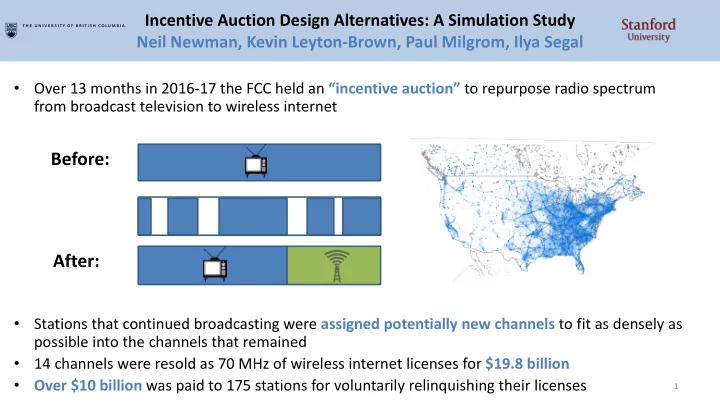

Incentive Auction Design Alternatives: A Simulation Study Neil Newman, Kevin Leyton-Brown, Paul Milgrom, Ilya Segal Over 13 months in 2016-17 the FCC held an “incentive auction” to repurpose radio spectrum • from broadcast television to wireless internet Before: After: Stations that continued broadcasting were assigned potentially new channels to fit as densely as • possible into the channels that remained 14 channels were resold as 70 MHz of wireless internet licenses for $19.8 billion • Over $10 billion was paid to 175 stations for voluntarily relinquishing their licenses • 1
This Paper 1. A general philosophy of market analysis via computationally intensive simulations 2. Some specific insights about the Incentive Auction design – Given that the auction was novel, extremely complex, and produced under time pressure , we wanted to understand: • which elements of the design were most important? • are there variations of the design that might have led to even better outcomes ? – We asked four questions concerning the auction’s design: • Was repacking the VHF band worth its added complexity? • Did scoring stations by population decrease the reverse auction cost? • Did it help to build custom software to repack stations? • How was performance affected by the procedure for deciding the number of channels to clear? – We answered these questions quantitatively using simulations • We assumed bidders myopically maximize their profit in each round • We used two distinct value models for robustness (one from the literature [Doraszelski et al. 2017], another we fit to bid data) 2
Simulation Methodology 1. Build an auction simulator – Choose an appropriate level of abstraction • auction rules are often incredibly complex! 2. Construct a parameterized bidder model – some parameters feed into bidder valuations – others help to specify how bidders will behave in the auction 3. Establish a probability distribution over the bidder model’s parameters 4. Draw many samples from this distribution 5. Run paired simulations holding sampled parameters fixed while varying some facet of auction design 6. Compare outcomes 3
~40 CPU Years Value Loss: Sum of values of stations removed from the air Cost of Acquiring Spectrum: Sum paid to winning stations Lower is better for both metrics
Recommend
More recommend